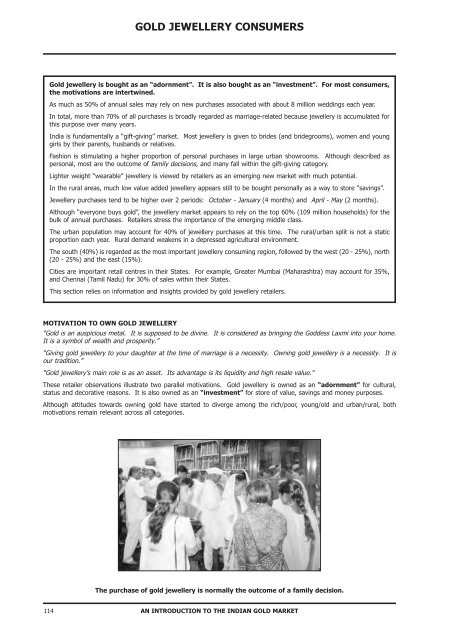Indian Gold Book:Indian Gold Book - Gold Bars Worldwide
Indian Gold Book:Indian Gold Book - Gold Bars Worldwide
Indian Gold Book:Indian Gold Book - Gold Bars Worldwide
You also want an ePaper? Increase the reach of your titles
YUMPU automatically turns print PDFs into web optimized ePapers that Google loves.
GOLD JEWELLERY CONSUMERS<br />
<strong>Gold</strong> jewellery is bought as an “adornment”. It is also bought as an “investment”. For most consumers,<br />
the motivations are intertwined.<br />
As much as 50% of annual sales may rely on new purchases associated with about 8 million weddings each year.<br />
In total, more than 70% of all purchases is broadly regarded as marriage-related because jewellery is accumulated for<br />
this purpose over many years.<br />
India is fundamentally a “gift-giving” market. Most jewellery is given to brides (and bridegrooms), women and young<br />
girls by their parents, husbands or relatives.<br />
Fashion is stimulating a higher proportion of personal purchases in large urban showrooms. Although described as<br />
personal, most are the outcome of family decisions, and many fall within the gift-giving category.<br />
Lighter weight “wearable” jewellery is viewed by retailers as an emerging new market with much potential.<br />
In the rural areas, much low value added jewellery appears still to be bought personally as a way to store “savings”.<br />
Jewellery purchases tend to be higher over 2 periods: October - January (4 months) and April - May (2 months).<br />
Although “everyone buys gold”, the jewellery market appears to rely on the top 60% (109 million households) for the<br />
bulk of annual purchases. Retailers stress the importance of the emerging middle class.<br />
The urban population may account for 40% of jewellery purchases at this time. The rural/urban split is not a static<br />
proportion each year. Rural demand weakens in a depressed agricultural environment.<br />
The south (40%) is regarded as the most important jewellery consuming region, followed by the west (20 - 25%), north<br />
(20 - 25%) and the east (15%).<br />
Cities are important retail centres in their States. For example, Greater Mumbai (Maharashtra) may account for 35%,<br />
and Chennai (Tamil Nadu) for 30% of sales within their States.<br />
This section relies on information and insights provided by gold jewellery retailers.<br />
MOTIVATION TO OWN GOLD JEWELLERY<br />
“<strong>Gold</strong> is an auspicious metal. It is supposed to be divine. It is considered as bringing the Goddess Laxmi into your home.<br />
It is a symbol of wealth and prosperity.”<br />
“Giving gold jewellery to your daughter at the time of marriage is a necessity. Owning gold jewellery is a necessity. It is<br />
our tradition.”<br />
“<strong>Gold</strong> jewellery’s main role is as an asset. Its advantage is its liquidity and high resale value.”<br />
These retailer observations illustrate two parallel motivations. <strong>Gold</strong> jewellery is owned as an “adornment” for cultural,<br />
status and decorative reasons. It is also owned as an “investment” for store of value, savings and money purposes.<br />
Although attitudes towards owning gold have started to diverge among the rich/poor, young/old and urban/rural, both<br />
motivations remain relevant across all categories.<br />
114<br />
The purchase of gold jewellery is normally the outcome of a family decision.<br />
AN INTRODUCTION TO THE INDIAN GOLD MARKET

















